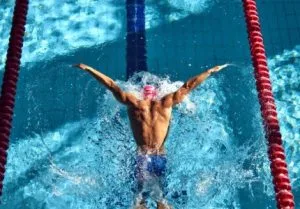Butterfly swimming is one of the most graceful yet challenging strokes in the water. Combining strength, coordination, and rhythm, this style gives you unparalleled sensations and speed in the water once mastered. In this blog post, we’ll explore the intricacies of butterfly swimming, share tips to help you improve your technique, and answer frequently asked questions.
Fundamentals of Butterfly Swimming
Butterfly swimming is a symmetrical stroke in which the body moves in a wave-like motion. The arms simultaneously rise and fall above the water, while the legs work together in a movement called the dolphin kick. Breathing is usually accomplished by lifting the head above the water while the arms are extended forward.
Technical Tips
- Body Position: Your body should be as close to the surface of the water and as straight as possible. Make sure your hips stay close to the surface and avoid slumping your lower back.
- Arm Pull: Enter the water with your arms simultaneously and pull them in a wide “S” motion. Push the water forcefully back, keeping your elbows high.
- Dolphin Kick: Bring your legs together and move them up and down in a powerful, rhythmic motion. Power your kick from your hips and keep your ankles flexible.
- Breathing: Lift your head out of the water with your arms extended forward and inhale. Exhale just before entering the water. Adjust your breathing rhythm to your swimming speed.
- Coordination: The most important aspect of butterfly swimming is coordination. You must coordinate your arm stroke, dolphin kick, and breathing.
Strengthening Exercises
Strengthening the muscles needed for butterfly swimming will help you swim more efficiently and quickly. Here are some exercises to help:
- Push-ups: Do push-ups to strengthen your chest, shoulders, and triceps muscles.
- Pull-ups: Do pull-ups to strengthen your back and arm muscles.
- Crunches: Do crunches to strengthen your abdominal muscles.
- Planks: Do planks to increase your full-body strength and endurance.
- Dolphin Kick Exercises: Practice dolphin kicks using a kickboard to increase the strength and flexibility of your legs.
Common Mistakes in Butterfly Swimming
- Raising the Head Too Much: If you raise your head too much while breathing, your body’s balance will be disrupted and resistance will increase.
- Keeping Your Elbows Low During Arm Pulls: If you do not keep your elbows high, the effectiveness of your arm pulls will decrease.
- Inadequate Dolphin Kick: A weak dolphin kick will slow your progress and tire you out.
- Poor Coordination: If your arm thrust, dolphin kick, and breathing are not in sync, you cannot swim efficiently.
Butterfly Swimming Tips:
- Flexibility: Butterfly swimming requires flexibility in the shoulders and ankles. Increase your flexibility by stretching regularly.
- Feel the resistance of the water and adjust your movements accordingly.
- Rhythm: Butterfly swimming is a rhythmic style. Perform your arm stroke, dolphin stroke, and breathing in a regular rhythm.
- Practice: The best way to master butterfly swimming is to practice. Improve your technique by swimming regularly.
- Swimming Courses: Attending swimming courses with a professional instructor will help you learn the right techniques and correct your mistakes.
Frequently Asked Questions
Is butterfly swimming difficult?
Yes, butterfly swimming is more challenging than other strokes. However, with regular practice and proper technique, anyone can learn to swim butterfly.
What muscles does butterfly swimming work?
Butterfly swimming exercises many muscles in the body, especially the shoulders, back, chest, arms, legs and abdominal muscles.
How many calories does butterfly swimming burn?
Butterfly swimming burns approximately 600-800 calories per hour. This amount can vary depending on your swimming speed and intensity.
How to swim butterfly faster?
Swimming faster with a butterfly stroke requires a strong arm stroke, an effective dolphin kick, and good coordination. You should also keep your body straight and avoid unnecessary movements to reduce water resistance.
Is it difficult to breathe while swimming butterfly?
Breathing in butterfly swimming can be difficult at first. However, with practice, you can find the right breathing rhythm.
Should I take swimming lessons?
Taking swimming lessons is the most effective way to learn proper techniques and correct your mistakes. With the help of a professional instructor, you can learn to swim faster and more safely.
Butterfly Swimming: Tips for a Powerful Swimming Style
We hope this blog post has answered your questions about butterfly swimming and provided you with some helpful tips. Remember, practice and proper technique are key to mastering butterfly swimming.
In our swimming courses, you can improve your butterfly technique with our experienced instructors and feel more confident in the water. For more information, please visit our website or contact us.



